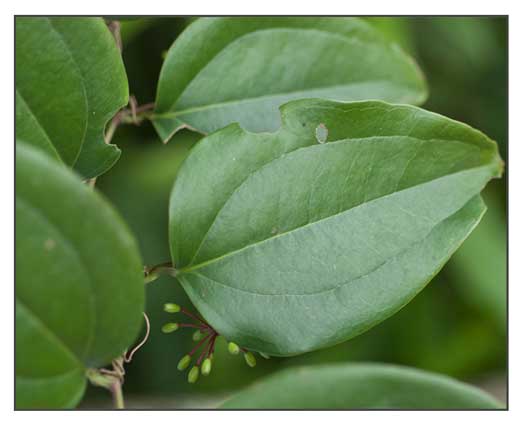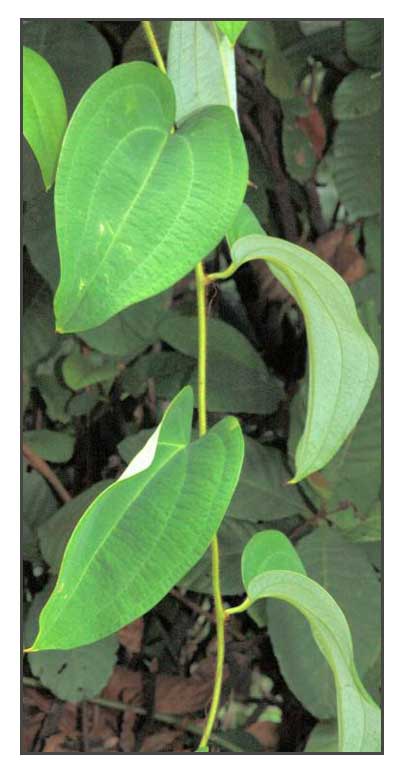 Gen info Gen info
Similax is a genus of about 300 to 500 species, found in temperate, tropics and subtropic zones worldwide.
Botany
Banag is a climbing woody vine reaching a height of several meters, occasionally to the canopy of trees it climbs. Stems are armed with few to many stout spines. Leaves are elliptic to oblong-ovate, 8 to 13 centimeters long, the base broadly rounded or slightly cordate, and the apex shortly and abruptly acuminate. Umbels are many flowered, about 2 centimeters in diameter. Flowers are fragrant, greenish-yellow, and about 5 millimeters long. Berries are globose, 5 to 8 millimeters in diameter, black when mature.
 Distribution Distribution
- In thickets and secondary forests at low and medium altitudes in Benguet, Pangasinan, Bulacan, Rizal, Bataan, Laguna and Quezon Provinces in Luzon.
Constituents
- Methanolic extract from rhizomes yielded six new phenolic compounds: (2S,3S)-5-O-β-d-glucopyranosyloxy-6-methyl-3‘-methoxy-3,7,3‘-trihydroxyflavan (1), (2S,3S)-5-O-β-d-glucopyranosyloxy-6-methyl-4‘-methoxy-3,7,4‘-trihydroxyflavan (2), 3β-(3‘,5‘-dihydroxyphenyl) 2α-(4‘‘-hydroxyphenyl)dihydrobenzofuran-5-carbaldehyde (3), (1-p-O-coumaroyl-6-O-feruroyl)-β-d-fructofuranosyl-α-d-glucopyranoside (4), (1-p-O-coumaroyl-3,6-di-O-feruroyl)-β-d-fructofuranosyl-α-d-glucopyranoside (5), and (6-O-feruroyl)-β-d-fructofuranosyl-(6-O-acetyl)-α-d-glucopyranoside (6). (1)
- Ethanolic extract yielded six phenylpropanoid glycosides, smilasides G-L (1-6), along with four known phenylpropanoid compounds, helonioside A, heloioside B, smilaside E, and (1-p-O-coumaroyl-6-O-feruroyl)-beta-d-fructofuranosyl-alpha-d-glucopyranoside, and 14 known phenolic compounds. (see study above) (2)
- Rhizomes yielded five compounds: 5,7-dihydroxy-chromone-3-O-α-L-rhamnopyranoside (1), resveratrol (2), astilbin (3), neoisoastilbin (4), catechin (5). (4)
and
- Study
yielded major secondary metabolites: one aromatic compound seselin (1) and two steroids ß-sitosterol (2) and stigmasti-4-ene-3-one (3). (see study below) (6)
Properties
- Depurative, emmenagogue.
- Studies have shown radical scavenging activity.
Parts used
- Rhizomes, roots.
Uses
Folkloric
- In the Visayas, decoction of fresh or dry rhizomes used as emmenagogue.
- Decoction of rhizomes and roots used as depurative.
- Rhizomes used for rheumatism.
- Decoction of roots or bark used by the Higanon tribe in Mindanao to relieve and prevent muscle pains or over fatigue in women, especially after childbirth. (5)
- Mature stems used as herbal tooth sticks by inhabitants of the Andaman and Nicobar Islands. (7) Leaves used to treat urinary tract problems. (8)
- Root decoction used as diuretic and for various kidney troubles. (9)
Studies
• Phenolic Compounds: Study of methanol extract of Smilax bracteana rhizomes yielded six new phenolic compounds with five other known compounds. (see study above) (1)
• Antioxidant / Radical Scavenging Activity: Ethanolic extract yielded six phenylpropanoid glycosides, smilasides G-L along with four known phenylpropanoid compounds and 14 known phenolic compounds. Compounds 1-6 exhibited moderate scavenging activities against DPPH radicals. (see constituents above) (2)
• Aromatic and Steroid Compounds / Known Biologic Activities: Study isolated major secondary metabolites: one aromatic compound seselin (1) and two steroids ß-sitosterol (2) and stigmasti-4-ene-3-one (3). These compounds have been shown to exhibit various biological activities such as anticancer, anti-fungal, and anti-inflammatory. (6)
Availability
Wild-crafted. |





 Distribution
Distribution